headrest Hyundai Getz 2006 User Guide
[x] Cancel search | Manufacturer: HYUNDAI, Model Year: 2006, Model line: Getz, Model: Hyundai Getz 2006Pages: 455, PDF Size: 11.23 MB
Page 271 of 455
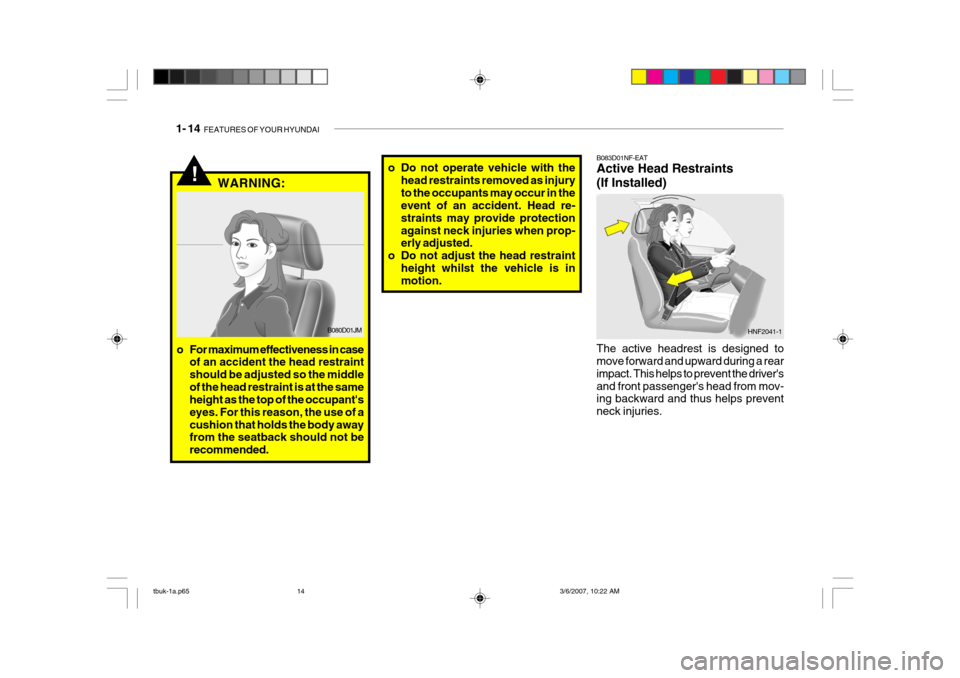
1- 14 FEATURES OF YOUR HYUNDAI
!WARNING:
B080D01JM
o For maximum effectiveness in case of an accident the head restraint should be adjusted so the middleof the head restraint is at the same height as the top of the occupant's eyes. For this reason, the use of acushion that holds the body away from the seatback should not be recommended.
o Do not operate vehicle with the
head restraints removed as injury to the occupants may occur in the event of an accident. Head re- straints may provide protectionagainst neck injuries when prop- erly adjusted.
o Do not adjust the head restraint height whilst the vehicle is inmotion.B083D01NF-EAT Active Head Restraints (If Installed) The active headrest is designed to move forward and upward during a rear impact. This helps to prevent the driver'sand front passenger's head from mov- ing backward and thus helps prevent neck injuries. HNF2041-1
tbuk-1a.p65
3/6/2007, 10:22 AM
14
Page 275 of 455
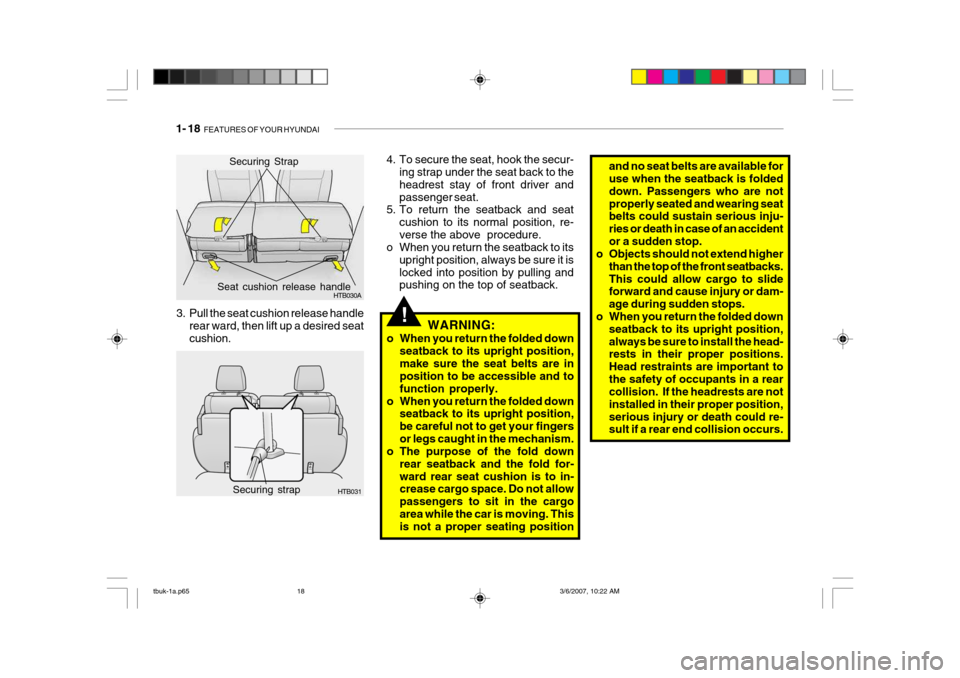
1- 18 FEATURES OF YOUR HYUNDAI
and no seat belts are available for use when the seatback is folded down. Passengers who are notproperly seated and wearing seat belts could sustain serious inju- ries or death in case of an accidentor a sudden stop.
o Objects should not extend higher
than the top of the front seatbacks.This could allow cargo to slide forward and cause injury or dam- age during sudden stops.
o When you return the folded down seatback to its upright position,always be sure to install the head- rests in their proper positions. Head restraints are important tothe safety of occupants in a rear collision. If the headrests are not installed in their proper position,serious injury or death could re- sult if a rear end collision occurs.
3. Pull the seat cushion release handle
rear ward, then lift up a desired seatcushion.
!WARNING:
o When you return the folded down seatback to its upright position, make sure the seat belts are in position to be accessible and to function properly.
o When you return the folded down seatback to its upright position,be careful not to get your fingersor legs caught in the mechanism.
o The purpose of the fold down
rear seatback and the fold for-ward rear seat cushion is to in- crease cargo space. Do not allow passengers to sit in the cargoarea while the car is moving. This is not a proper seating position
4. To secure the seat, hook the secur-
ing strap under the seat back to the headrest stay of front driver andpassenger seat.
5. To return the seatback and seat
cushion to its normal position, re-verse the above procedure.
o When you return the seatback to its
upright position, always be sure it islocked into position by pulling and pushing on the top of seatback.
HTB030A
Seat cushion release handle
HTB031Securing strap
Securing Strap
tbuk-1a.p65
3/6/2007, 10:22 AM
18
Page 285 of 455
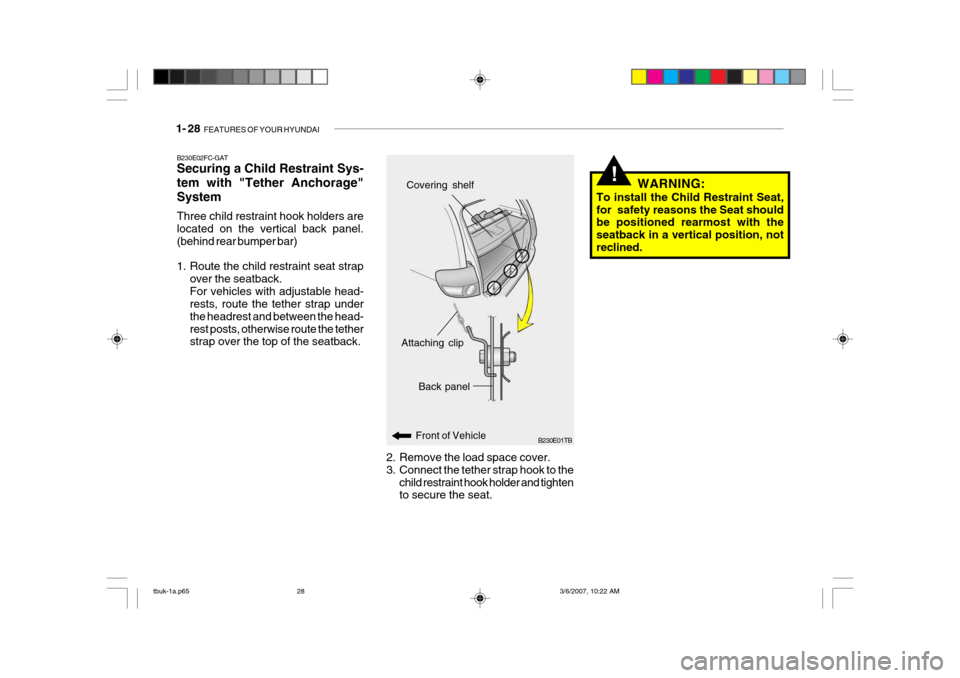
1- 28 FEATURES OF YOUR HYUNDAI
!
B230E01TB
Back panel
Front of Vehicle
Attaching clip
Covering shelf
2. Remove the load space cover.
3. Connect the tether strap hook to the child restraint hook holder and tighten to secure the seat. WARNING:
To install the Child Restraint Seat, for safety reasons the Seat should be positioned rearmost with the seatback in a vertical position, notreclined.
B230E02FC-GAT Securing a Child Restraint Sys- tem with "Tether Anchorage"System Three child restraint hook holders are located on the vertical back panel. (behind rear bumper bar)
1. Route the child restraint seat strap
over the seatback. For vehicles with adjustable head- rests, route the tether strap under the headrest and between the head-rest posts, otherwise route the tether strap over the top of the seatback.
tbuk-1a.p65 3/6/2007, 10:22 AM
28
Page 355 of 455
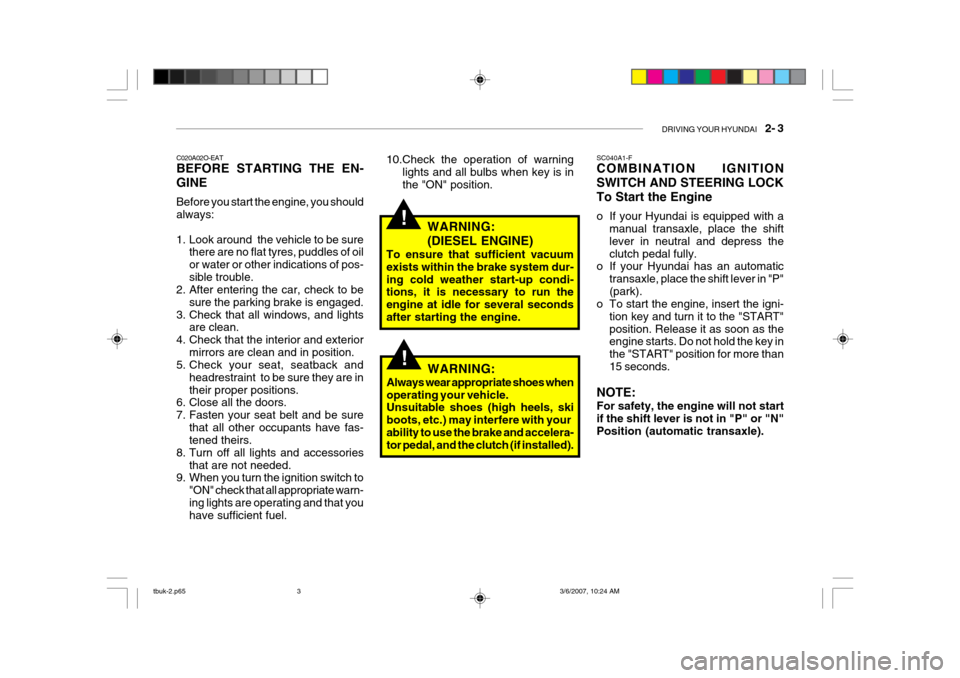
DRIVING YOUR HYUNDAI 2- 3
!
C020A02O-EAT BEFORE STARTING THE EN- GINE Before you start the engine, you should always:
1. Look around the vehicle to be sure
there are no flat tyres, puddles of oil or water or other indications of pos-sible trouble.
2. After entering the car, check to be
sure the parking brake is engaged.
3. Check that all windows, and lights are clean.
4. Check that the interior and exterior mirrors are clean and in position.
5. Check your seat, seatback and
headrestraint to be sure they are intheir proper positions.
6. Close all the doors.
7. Fasten your seat belt and be sure
that all other occupants have fas- tened theirs.
8. Turn off all lights and accessories that are not needed.
9. When you turn the ignition switch to
"ON" check that all appropriate warn- ing lights are operating and that you have sufficient fuel. 10.Check the operation of warning
lights and all bulbs when key is in the "ON" position.
WARNING: (DIESEL ENGINE)
To ensure that sufficient vacuum exists within the brake system dur-ing cold weather start-up condi- tions, it is necessary to run the engine at idle for several secondsafter starting the engine. SC040A1-F COMBINATION IGNITION SWITCH AND STEERING LOCKTo Start the Engine
o If your Hyundai is equipped with a
manual transaxle, place the shift lever in neutral and depress theclutch pedal fully.
o If your Hyundai has an automatic
transaxle, place the shift lever in "P"(park).
o To start the engine, insert the igni-
tion key and turn it to the "START"position. Release it as soon as the engine starts. Do not hold the key in the "START" position for more than15 seconds.
NOTE: For safety, the engine will not start if the shift lever is not in "P" or "N"Position (automatic transaxle).
!WARNING:
Always wear appropriate shoes when operating your vehicle. Unsuitable shoes (high heels, ski boots, etc.) may interfere with yourability to use the brake and accelera- tor pedal, and the clutch (if installed).
tbuk-2.p65 3/6/2007, 10:24 AM
3
Page 452 of 455
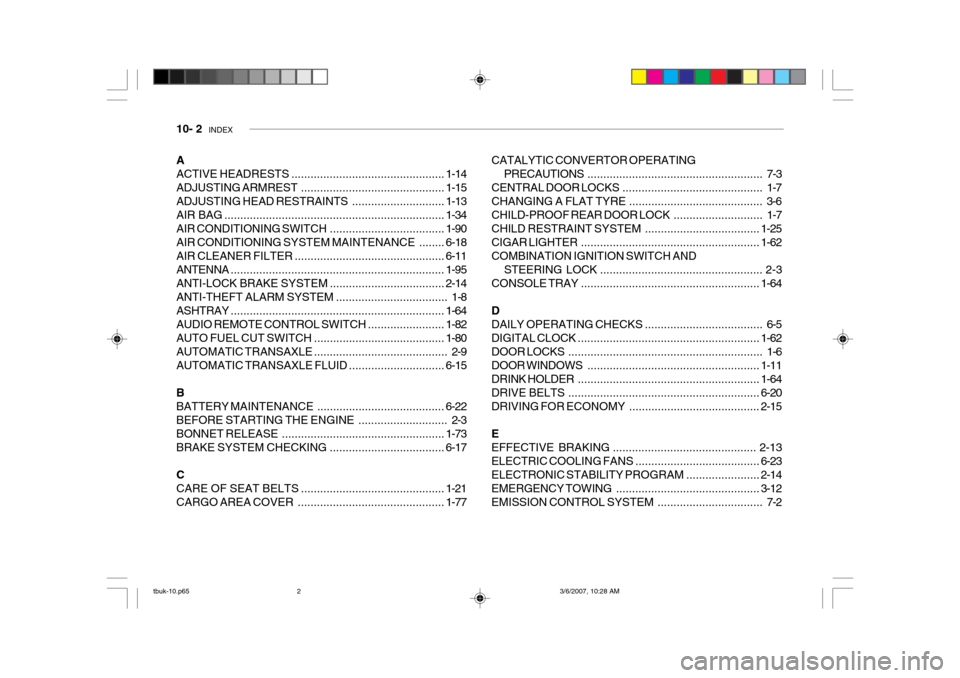
10- 2 INDEX
A
ACTIVE HEADRESTS ................................................ 1-14
ADJUSTING ARMREST ............................................. 1-15
ADJUSTING HEAD RESTRAINTS............................. 1-13
AIR BAG ..................................................................... 1-34
AIR CONDITIONING SWI TCH .................................... 1-90
AIR CONDITIONI NG SYSTEM MAINTENANCE ........ 6-18
AIR CLEANER FILTER ............................................... 6-11
ANTENNA ................................................................... 1-95
ANTI-LOCK BRAKE SYSTEM .................................... 2-14
ANTI-THEFT ALARM SYSTEM ................................... 1-8
ASHTRAY ................................................................... 1-64
AUDIO REMOTE CONTROL SW ITCH ........................1-82
AUTO FUEL CUT SWITCH ......................................... 1-80
AUTOMATIC TRANSAXLE ......... ................................. 2-9
AUTOMATIC TRANSAXLE FLUID ..............................6-15
B
BATTERY MAINTENANCE ........................................ 6-22
BEFORE STARTING THE ENGINE ............................ 2-3
BONNET REL EASE ................................................... 1-73
BRAKE SYSTEM CHECKI NG .................................... 6-17
CCARE OF SEAT BELTS ............................................. 1-21
CARGO AREA COVER .............................................. 1-77CATALYTIC CONVERTOR OPERATING
PRECAUTIONS ....................................................... 7-3
CENTRAL DOOR LOCKS ............................................ 1-7
CHANGING A FLAT TYRE .......................................... 3-6
CHILD-PROOF REAR DOOR LOCK ............................ 1-7
CHILD RESTRAINT SYSTEM .................................... 1-25
CIGAR LIGHTER ........................................................ 1-62
COMBINATION IGNITION SWITCH AND STEERING LOCK ................................................... 2-3
CONSOLE TRAY ........................................................ 1-64
DDAILY OPERATING CHECKS ..................................... 6-5
DIGITAL CLOCK ......................................................... 1-62
DOOR LOCKS ............................................................. 1-6
DOOR WINDOWS ...................................................... 1-11
DRINK HOLDER ......................................................... 1-64
DRIVE BELTS ............................................................ 6-20
DRIVING FOR ECONOMY ......................................... 2-15
EEFFECTIVE BRA KING............................................. 2-13
ELECTRIC COOLING FANS ....................................... 6-23
ELECTRONIC STABILITY PROGRAM .......................2-14
EMERGENCY TOWING ............................................. 3-12
EMISSION CONTROL SYSTEM ................................. 7-2
tbuk-10.p65 3/6/2007, 10:28 AM
2